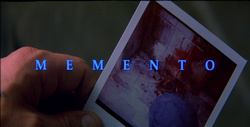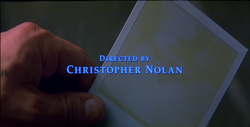(This brief essay was inspired by Jim Emerson’s Opening Shots project.)
The Opening Shot of Memento
 A man’s hand holds a Polaroid photograph, but who would want to commemorate such a gruesome scene? The picture shows a body lying face-down on a floor, blood everywhere.
A man’s hand holds a Polaroid photograph, but who would want to commemorate such a gruesome scene? The picture shows a body lying face-down on a floor, blood everywhere.
This might be a crime-scene photo, but that conclusion doesn’t feel right. If the man were a police photographer or officer, why would he linger over this particular image? It’s mundane for that line of work, yet the man holds it for half a minute, as if studying it.
Then he shakes it, and we notice something on his hand, dark but unclear. And the photograph begins to fade. We might observe that the darkness on his hand is a tattoo, with letters: “i” and “s.”
He shakes the photo again, and it fades from cold blues and crimsons to greenish blobs, indecipherable.
So starts Memento, Christopher Nolan’s breakout movie, and the film is so clever – with its structure mimicking the protagonist’s “condition,” and with the audience sharing his continual confusion – that it’s easy to overlook the density of this elegant 80-second shot.
Most obviously, the opening tells the audience that time is flowing in reverse, preparing it for the way Nolan’s script plays with the sequence of events – unfolding backward and forward simultaneously until they meet at the end of the movie. The shot is, of course, the beginning of Memento’s story but also its narrative ending, just as Leonard Shelby’s murder of Teddy marks the end of one quest but the beginning of the search for his next “John G.”
 The de-developing photograph serves as a metaphor for Leonard’s memory, starting clear but fading in a matter of seconds or minutes into nothingness. It reflects how his lack of short-term memory allows him to act with internal moral impunity, because his conscience will soon be as blank as that Polaroid.
The de-developing photograph serves as a metaphor for Leonard’s memory, starting clear but fading in a matter of seconds or minutes into nothingness. It reflects how his lack of short-term memory allows him to act with internal moral impunity, because his conscience will soon be as blank as that Polaroid.
The short-lived image is contrasted with the permanence of the ink on Leonard’s hand, but the fragmentary nature of the tattoos makes them equally problematic. The fact that we can’t read the tattoo in this shot hints at its own shortcomings as a reminder, as Leonard will inevitably twist its meaning.
And, finally, the act of shaking the picture, seemingly erasing what it shows and what he’s done, implicates Leonard, in the sense that he’s trying to make the picture disappear. There is part of Leonard’s brain that has created his condition as a means of self-preservation. He must continue to avenge his wife’s murder – no matter how many “John G.”s he kills – because it’s the only thing that gives him purpose.

